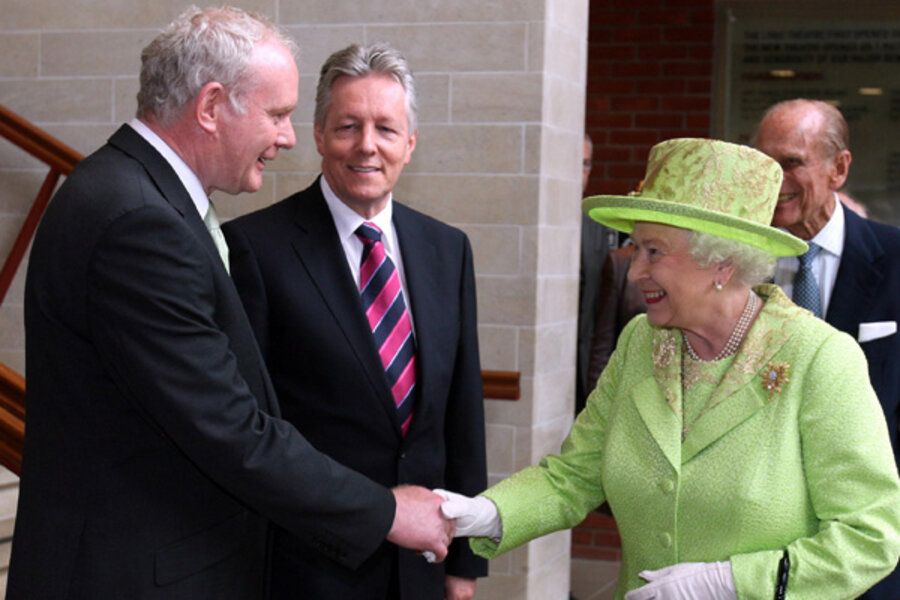Historic handshake between British queen and Irish republican
Loading...
| Dublin, Ireland
It was a moment pregnant with symbolism, but one that remained closed to the public and was initially intended to not even be photographed: a senior Irish republican shaking the hand of the British Queen.
The deputy first minister of Northern Ireland shaking the hand of the monarch who remains head of state of Northern Ireland would normally be a fairly mundane affair. But the office is held by Martin McGuinness – not just a Sinn Féin politician, but also a leader of the Irish Republican Army, which fought a three-decade bloody civil conflict against British forces.
Given who he is, the handshake is being hailed as the final major act of the Irish peace process.
Sinn Féin has said Mr. McGuinness told the queen that the meeting was a "powerful signal that peace-building requires leadership."
Also at the meeting, organized in Belfast by the charity Co-operation Ireland, was President of Ireland Michael D. Higgins, his wife Sabina, and the queen's husband, Prince Philip, Duke of Edinburgh.
Although a photograph has been released to the press, the handshake between McGuinness and the British queen occurred behind closed doors. A second meeting was held a short time later, and the two shook hands again in front of television cameras for later broadcast.
Initial plans not to release a photograph of the handshake were widely criticized in Ireland.
At this second meeting, McGuinness spoke to the queen in Irish Gaelic, saying "slán agus beannacht," and explained it meant "goodbye and Godspeed."
Speaking to reporters a day in advance of the meeting, McGuinness said he was "still a republican."
McGuinness does not deny having been a member of the IRA, but claims he left the organization in 1974 in order to concentrate on politics as a member of Irish republican political party Sinn Féin. Few believe him. Across Ireland it is assumed McGuinness was a member of the now defunct IRA army council, the secret top brass of Irish republicanism, until it was finally wound up some time after 2005.
In another twist, McGuinness is alleged to have been IRA leader when it killed Lord Louis Mountbatten, the uncle of her husband.
"Today is a huge event and it is, in a sense, the ultimate handshake," said former British Secretary of State for Northern Ireland John Reid, speaking to the BBC.
Mr. Reid went on to say the "hugely significant step" was only one more in a process of reconciliation that "may take generations" to complete.
Setting precedent
It's not the first time a Sinn Féin politician has met Britain's queen. In 2011, Michael Browne, the mayor of the Irish town of Cashel, challenged party policy by meeting the queen during her first ever visit to the Republic of Ireland. (Sinn Féin is active in both Ireland and Northern Ireland.) Party members at the time complained the move was premature. Mr. Browne, who had been diagnosed with cancer, died in December 2011.
What makes today's meeting different is McGuinness's stature, both within Irish republicanism, where he is viewed as a hero, and as a senior elected figure.
Mick Fealty, who runs the Northern Irish political website Slugger O'Toole, says Sinn Féin is now playing catch-up to public opinion.
"Last year they misjudged the effect of the queen's visit to Ireland and were very much seen as being out of step with the [public] mood," he says.
Mr. Fealty also says meeting the monarch is simply something the deputy first minister, the second most powerful figure in Northern Ireland's power-sharing assembly, must do.
"It's also about Martin [McGuinness] stepping-up to the reality of his own office."
Others think the symbolism is not so much a celebration of normalcy but a recognition of changed times and the emptying of meaning from political claims.
British political commentator Mick Hume says the meeting represents a final admission of the exhaustion not only of radical Irish republicanism, but also Britain's "right to rule."
"Britain's claim on Northern Ireland is a much more neutral claim now. It's almost there as a leftover from the past rather than something they'd put their lives on the line to defend," he says.
"You can see this in the British political class' shrug of indifference about Northern Ireland. You couldn't imagine a figure like [the late outspoken British unionist politician] Enoch Powell now. For him, Ireland was at the center of the British Empire."







